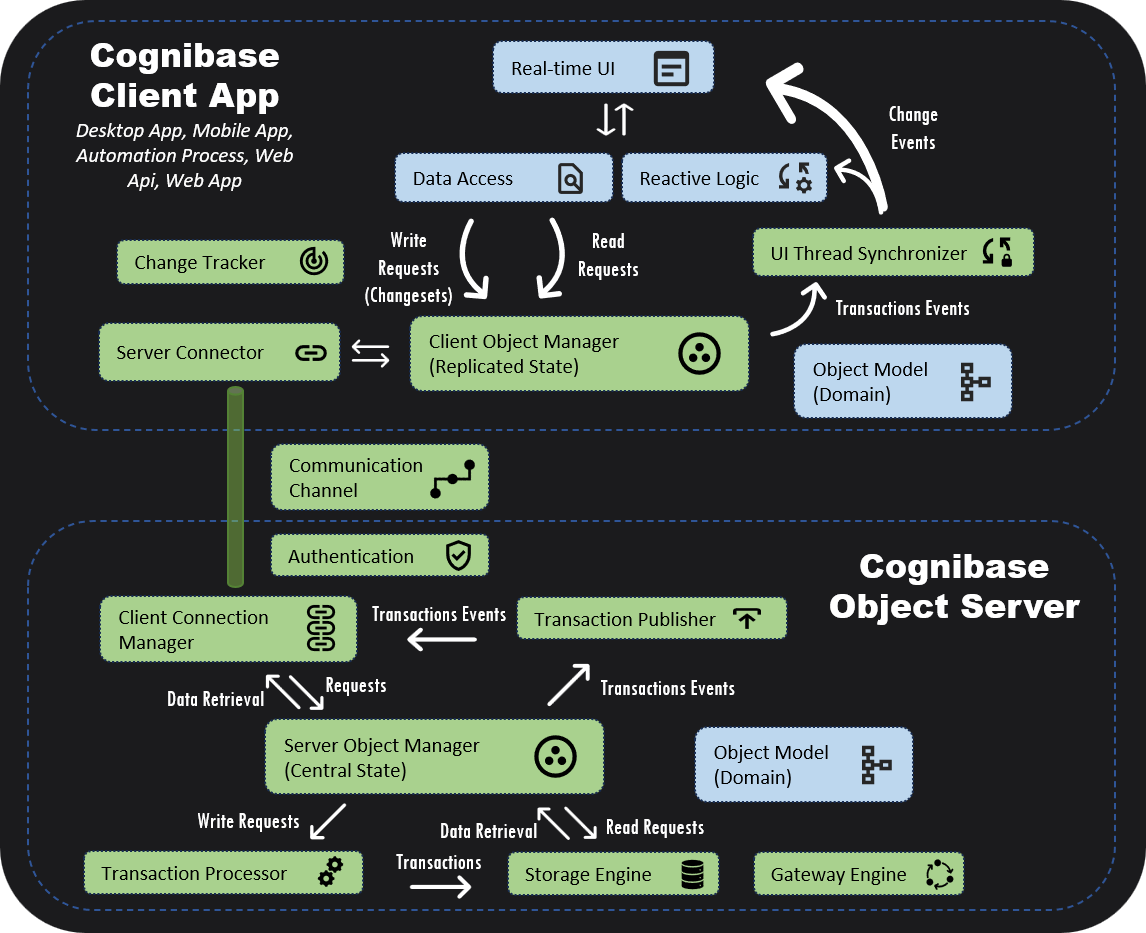Cognibase
Build Better Applications with Less Code
A super productive universal software stack and simplified architecture
Leverage a state-of-the-art framework that's both streamlined and modular, offering a pre-configured architecture, a versatile and managed backend, along with integrated enterprise-grade components.


Robust Features to Build Anything
Cognibase is not bound to single data store, but offers an Object Oriented Real-Time layer on top of any SQL database and other storage types.
- MS SQL Server
- Azure SQL Database
- Oracle Server
- PostgreSQL
- SQLite
- Binary Files
- HTTP/Orion NGSIv2
Learn more >
Supports all major operating systems: Windows, Linux, MacOS, Android, iOS.
Supports both the new cross-platform .NET as well as the legacy .NET Framework 4.8 and the .NET Standard 2.0 providing a straightforward migration path.
Supports any possible target: Cloud, Server, Desktop, Mobile, Edge - soon also able to support blazor and web assembly.
Learn more >
Cognibase integrates well with .NET UI components and frameworks so developers can build higly interactive User Interfaces even for large amount of data.
Cognibase fires standard events, such as PropertyChanged, CollectionChanged, while synchronizing the execution at the UI thread.
Learn more >
Cognibase offers declarative data modeling through .NET attributes, allowing developers to specify various aspects of entities classes and fields. This includes options to define whether a field is persisted or memory-only, caching preferences, field loading timings, and monitoring capabilities. The declarations support data formatting and constraints like minimum and maximum values, streamlining the development process and making it more robust.
Learn more >
Cognibase incorporates standard UML class diagram concepts into its framework, enabling rich object modeling. It supports features like inheritance, field overriding, and two-way associations, along with compositions that accommodate cardinalities. The platform also allows the creation of hierarchies among classes, providing developers with a versatile toolkit for complex data modeling.
Learn more >
Cognibase features transactional data synchronization and replicated object states. Servers receive client requests as changesets, which are validated and processed into transactions after applying business rules. These transactions are then pushed to clients, synchronizing their local state. Finally, client-level change events are triggered to reflect these updates, ensuring real-time data integrity across the system.
Learn more >
Cognibase offers granular event subscription capabilities for UI bindings and real-time data synchronization. Users can listen for transactional changes on multiple levels—from global updates affecting all data items, to type-specific changes, down to changes on individual instances. Additionally, it supports standard .NET property change events, allowing you to capture both transactional and local changes. This multi-layered approach to event handling ensures that applications remain responsive across all components.
Learn more >
Cognibase provides comprehensive change tracking across entire object graphs, not just individual objects. This includes continuously monitoring single relations, reference lists, and even back references within the object hierarchy. This level of granularity ensures that all interconnected data elements are consistently synchronized, thereby enhancing data integrity across the application.
Learn more >
Cognibase features a robust transactional engine with optimistic locking, which enables advanced validation, conflict detection, and conflict management. It offers multiple modes for handling conflicts, from an "always merge" approach to customized collision resolutions. This flexibility allows developers to maintain data integrity while adapting to specific needs, thereby enhancing transactional reliability.
Learn more >
Cognibase features a modular inter-process communication engine, supporting both WebSocket and Named Pipes protocols. It also offers the ability to manage multiple interconnected child processes, all while constantly tracking their connection status. This not only facilitates seamless communication between processes but also boosts system reliability.
Learn more >
Cognibase comes equipped with robust built-in authentication mechanisms, including LDAP, Active Directory, OAuth2.0 (under development) and local authentication (Linux PAM / Windows SAM). Additionally, it offers a pre-configured Identity Entity Model, streamlining the integration of secure identity management into your application. It is well-suited for any type of application, even for enterprise applications within large organizations.
Learn more >
Cognibase's Gateway Engine offers robust data stream ingestion capabilities, allowing entities to be fully or partially bound to external data sources. Using either poll or push-based methods, fields within an Entity can easily be configured to represent sensor data, aligning with industry standards like OPC. This feature provides exceptional flexibility for real-time data integration and management.
Learn more >
Cognibase offers a built-in Object-Oriented Query Language (OOQL), designed for real-time data access and management. Available in both literal and verbose forms, OOQL allows for dynamic queries that can populate Live Collections, which are continuously updated and validated. This feature simplifies data retrieval and enhances the reactivity of applications.
Learn more >
Cognibase's unique Live References and Live Collections features ensure real-time, consistent object graph views across replicated client states. Any changes made to entity relations, whether single references or reference lists, are automatically synchronized. OOQL queries can be employed to construct live collections that adaptively update their membership based on object changes. In all scenarios, granular events are triggered to indicate changes, offering a dynamic and cohesive data management experience.
Learn more >
In Cognibase, the Proxy Server serves as an additional layer that handles the replication and management of object states between different instances of the application. This role is crucial when you need to scale the system horizontally to accommodate more users or handle increased data traffic. By distributing the object states efficiently, the Proxy Server ensures that each instance has consistent and up-to-date information.
Learn more >